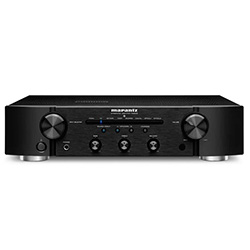 Audiolab is one of the pillars of the British Hi-FI industry. That’s why it is crucial for you to see all the Audiolab 6000A specs in this comprehensive Audiolab 6000A review.
Audiolab is one of the pillars of the British Hi-FI industry. That’s why it is crucial for you to see all the Audiolab 6000A specs in this comprehensive Audiolab 6000A review.
Audiolab 6000A review
Specs and features
The Audiolab 6000A amplifier has three operating modes: the main one, where both the preamplifier and the power amplifier function, the Pre-Power amplifier mode for connecting, for example, to a home theater system and the Pre mode, in which the device works only as a preamplifier. The power amplification stage Audiolab 6000A operates in AB class and delivers 50 watts per channel to 8 ohms, with maximum currents of up to 9 A, even in the most difficult loads. The output stage, implemented on discrete elements, uses the topology CFB (Complementary Feedback - complementary feedback), which provides excellent linearity and temperature stability, while the open circuit current remains independent of the temperature of the output transistors. A large 200VA toroidal transformer, with 4x15000 uF storage capacitors (60,000 uF in total), helps the amplifier precisely control the speakers, providing excellent dynamic range.
Design and build
The preamplifier section is implemented by the designers as simple as possible in order to maintain the purity of the audio signals, while from the linear inputs they enter the precision analog volume control. Much effort has been put into optimizing the physical trace of the connections inside the Audiolab 6000A to protect the sensitive section of the preamplifier from noise. All this, plus the use of independent low-noise power supplies for critical stages, helps to achieve such high quality sound that allows this model to compete with much more expensive analog amplifiers, without even taking into account the impressive digital capabilities of the Audiolab 6000A.

Connectivity
The developers also provided for the possibility of using the device as a power amplifier or pre-amplifier, for which there are separate inputs and outputs on the rear panel. There is Bluetooth, phono input and four digital inputs - a pair of optical and coaxial, capable of receiving a signal as high as 24 bit / 192 kHz.
Pros and Cons
Pros
- The flexibility provided by the slew of digital inputs allowed me to streamline and simplify my stereo
- Good bass control
Cons
- I find the front panel unattractive
Common features
Product
Model
Brand
Reviews
Amplifier
Channels
Power output (RMS), W/Ohm
Power output per channel, W/Ohm
Output Impedance, Ohm
Frequency response
THD in stereo, %
Signal-to-noise ratio, dB
Audio features
Digital to analog converter (DAC)
Speaker A/B switching
Pure direct mode
Connectivity
Wi-Fi
Bluetooth
Ethernet (RJ45)
Control
Bass
Treble
Balance
Remote control
Extensive connection
Optical digital input/output
Coaxial digital input/output
Phono (MM) input
Subwoofer output
Headphone outputs
USB
Preamplifier outputs (pair)
Main inputs (pair)
Line level inputs (pair)
XLR inputs (pair)
Record outputs (pair)
DC trigger output (12V)
Remote control input/output (IR)
RS-232
Additional features
Auto power off
Built-in display
Power
Power consumption, W
Power consumption standby, W
User manual
Manual
Dimensions
Size W x H x D, cm/inches
Weight, kg/lbs
Other
Release year





